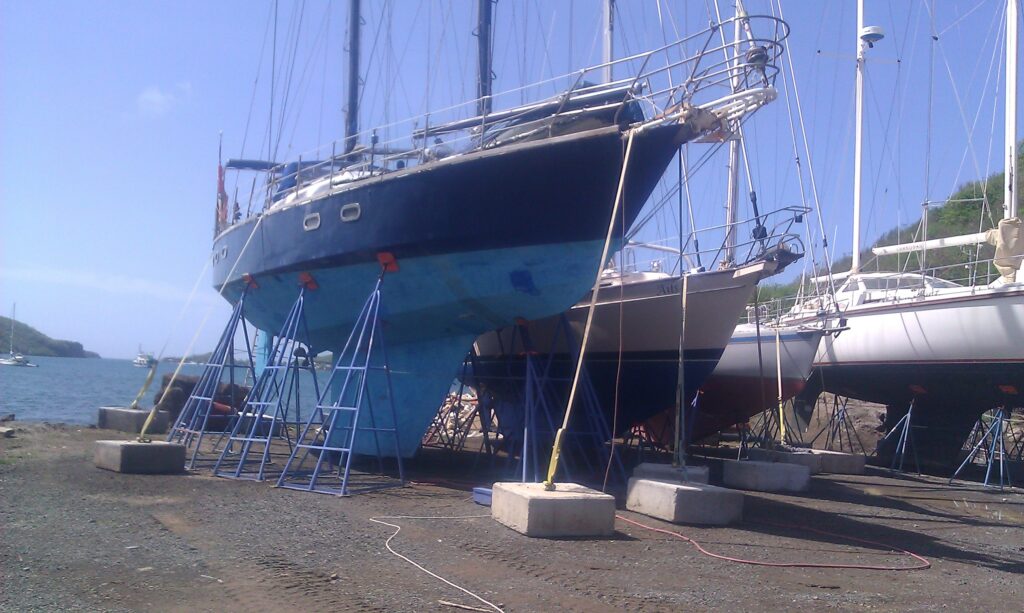
Are you thinking of buying a boat? There are a lot of choices, but basically sail or power. Once that basic decision is made, then there is the question of hull material.
What’s it for?
Many people fall in love with a boat and the hull material comes with it. But it should be a conscious choice. I chose steel because of the type of sailing I had in mind, with the likelihood of hitting a reef occasionally…
So think about what use you’ll make of it – and what your budget is.
Most boats today are made of fibreglass (GRP or glass reinforced polyester). GRP has many advantages, but there are disadvantages too. Here, we are going to look at the wide choice of hull materials available, with the major advantages/disadvantages of each.
Fibreglass (Basic/Traditional)
Fibreglass is the most common production material today. Older boats used very heavy ‘layups’ – thicknesses of glass strands, woven or chopped.
Epoxy resins are slowly taking over from polyester resins. They have lower water absorption properties.
Widely used for high volume production boats.
For: GRP has a good strength to weight ratio, low maintenance requirement, is cheap to build in high volume, and has moderate repair complexity – minor repairs are easily dealt with by the average handyman.
Against: Older compounds can be subject to osmosis (boat pox, which can be cured), and bleaching (‘chalking’) in strong UV, though modern compounds are less susceptible to this.
Ideal for: All round uses – fishing boats, sailing boats, dinghies, trawlers, even minesweepers!
Composite (Exotic)
Sometimes known as exotics, they may use Kevlar or carbon fibre reinforcement, with an epoxy base.
For: High strength to weight ratio.
Against: Expensive to build, expensive and technically complex to repair.
Ideal for: Racing and high performance craft, big budgets.
Composite (Epoxy on foam core)
This is an increasingly popular construction for one-offs, using sheets of a plastic foam for stiffness.
For: Good Strength to weight ratio, cheap and quick to build.
Against: Not easy to repair.
Ideal for: Home build, one off designs.
Composite (strip planked, epoxy coated)
Usually built using cedar strip planks for stiffness, strength and shape.
For: Moderate strength to weight, cheap and quick build.
Against: Moderately complex to repair.
Ideal for: One off and home build projects.
Wood (traditional)
A variety of planking types: clinker (overlapped), carvel, diagonal (single/double/triple). Double or triple diagonal may be laid up cold or oven cured.
For: Lovers of wood, tradition, low technology (except where baked – hot moulded).
Against: Lower strength to weight ratio. Increasingly difficult to find craftsmen for repairs, high maintenance requirement, multi-skin builds may de-laminate over time (the older glues were fairly low-tech).
Ideal for: traditionalists.
Wood (plywood)
Plywood really kicked off the home-build market way back in the early 1950’s.
For: Cheap and easy to build, moderate strength to weight ratio.
Against: Moderate maintenance requirement, older boats may de-laminate.
Ideal for kits and home build projects.
Steel
For: High strength:weight (boats over 38’-40’), cheap and easy to build, cheap and low-tech repairs and modifications, Very durable.
Against: Corrosion/maintenance.
Ideal for: All round use, one-offs, home build, polar expeditions,
Aluminium Alloy
For: High strength:weight, durable, low maintenance (no painting).
Against: Specialist repairs, corrosion.
Ideal for: Those who want higher performance with a durable material.
RIBs
Rigid inflatable boats usually have GRP base hulls, with inflatable collars, and really fall outside the scope of this article.
For: Light
Against: Inflatables are more easily punctured than a solid hull.
Conclusion
As with most things, you pay your money and take your choice. GRP is by far the most popular material, but there are others, depending on the use you have in mind. Steel is more widely in bigger vessels where one-off builds are more common. It is easy to modify, but does come with a requirement for keeping the paintwork intact. Modern epoxy coatings are good for 20 years if applied properly and well looked-after.
Traditional wooden boats are fewer and further between and have a high maintenance overhead. If you’re buying a boat and want the ultimate in looks and class, then a well-built and well-maintained wooden boat, power or sail, is very hard to beat if you have deep pockets. If you want performance, though, then it’s best to look for another material.
Which ever hull material you opt for when you buy a used boat, make sure that you get it properly surveyed (unless of course it’s a small dinghy or inflatable), or checked by a knowledgeable friend. Plywood, aluminium and steel boats may have been home-built, with variable quality and potential hidden problems.
If you’re thinking about buying a boat, check out the how to make sure you buy the right one for you.
Get more of my boat stories with an occasional message in a bottle:



